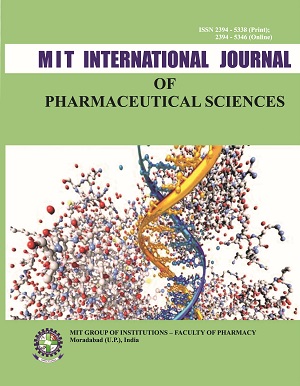
MIT INTERNATIONAL JOURNAL OF PHARMACEUTICAL SCIENCES (MITIJPS)
ISSN 2394-5338 (Print); 2394-5346 (Online)
Volume 7, Issue 2, 2022
This is open access Journal
Global Impact factor:0.565
SJIF Impact factor: 5.296
MITIJPS
Volume 3, Issue 1, 2017
Review Article
Recent trends in impurity profiling of pharmaceutical products
Anurag Jain*, Sanjay Sharma
SVKM’S Narsee Monjee Institute of Management Studies, School of Pharmacy and Technology Management, Mumbai-Agra Road, Shirpur, India.
*Corresponding Author. Tel.: +91 7507211402; E-mail address: jainanurag883@gmail.com
Abstract
Impurity plays a major role in pharmaceuticals therefore profiling of impurity is very important. There are various forms of impurities incorporated in the pharmaceuticals. These impurities are classified into three main categories such as organic, inorganic and residual solvents. Organic impurities include intermediate, starting material, degradation products, reagents, ligands, catalyst and by products. Whereas inorganic impurities are heavy metals, residual solvent, inorganic salt, filter-aids, charcoal and reagents. In pharmaceuticals impurities originate from various sources like formulation related impurities, synthetic intermediates, impurities arising during storage, impurities related to stereochemistry of the compound and most important is functional group related impurities. There are several methods used for the identification of impurities in pharmaceuticals but characterization of impurities is an important method of identification. Characterization includes nuclear magnetic resonance spectrometry (NMR) and mass spectrometry (MS). There are some recent hyphenated techniques for impurity profiling coupled with mass spectrometry like LC-MS, LC-MS-MS, GC-MS, HPLC-DAD-MS, HPLC-DAD-NMR-MS, capillary electrophoresis-mass spectrometry, and tandem spectrometry.
Keywords: Impurity profile, Degradation, Photolytic cleavage, Decarboxylation, Pharmaceutical impurities
Original Article
Phytochemical evaluation, anthelmintic and analgesic activities of butanol fraction of Adenanthera pavonina L. bark extract
Sujit Dash*, Sunil K. Kanungo, Amaresh C. Sahoo, Chandrasekhar Barik, Bishwanath Mishra
Institute of Pharmacy & Technology, Salipur, Cuttack, Odisha, India.
*Corresponding Author. . Tel.: +91 9438276626; E-mail address: discoversujit@gmail.com
Abstract
Adenanthera pavonina L. (Leguminosae) is a deciduous fast growing, unarmed tree, found naturally in India. Traditionally, it had been used to treat many diseases. The paper presents the phytochemical evaluation, anthelmintic and analgesic studies of butanol fraction of Adenanthera pavonina L. The ethanol bark extract was fractionated with pet ether, chloroform ethyl acetate, butanol and concentrated under vacuum at 40-60°c which yields a residue (3.3 w/w, 4.8w/w, 6.26%w/w 7.78w/w) which were stored in a desiccators at room temperature. It can be concluded from this study that butanol fraction of ethanol bark extract of Adenanthera pavonina L. possess significant anthelmintic and analgesic activity.
Keywords:Adenanthera pavonina L., Fluorescence, Pheretima posthuma, Physicochemical, Phytochemical
Original Article
Synthesis and characterization of novel sesamol derivatives having 2-(benzo- [d][1,3] dioxol-5-yloxy)acetohydrazide scaffold
Shailesh K. Singha,*, Laxmi Tripathib, Prem Singha
aLTR Institute of Technology, Meerut, Uttar Pradesh, India.
bMoradabad Eductional Trust, Group of Institutions, Faculty of Pharmacy, Moradabad, Uttar Pradesh, India.
*Corresponding Author. Tel.: +91 9358383448; E-mail address: ssshaileshsingh1@gmail.com
Abstract
A new series of 2-(benzo- [d],[1,3]dioxol-5-yloxy) acetohydrazide derivatives were synthesized from sesamol and characterized from various spectral methods. All derivatives were synthesized by the given schemes and reaction process was monitored by thin layer chromatography. The structures of synthesized derivatives were confirmed by FT-IR, 1 H NMR spectroscopy and elemental analysis methods.
Keywords: 2-benzo(1,3)-dioxol5-yloxy) acetohydrazide, Sesamol, Synthesis, Characterization
Original Article
Anti-inflammatory activity of methanolic extract of Corchorus depressus (L.) Stocks
Tapas K. Khuntiaa,*, U. N. Nandab, A. K. Senapatic
aDepartment of Pharmacology, Sri Jayadev College of Pharmaceutical Sciences, Naharkanta, Bhubaneswar, Odisha, India.
bDepartment of Pharmaceutics, Seemanta Institute of Pharmaceutical Sciences, Jharpokharia, Mayurbhanj, Odisha, India.
cDepartment of Pharmacology, Institute of Pharmacy and Technology, Salipur, Cuttack, Odisha, India.
*Corresponding Author. Tel.: +91 9040661816: E-mail address: tkhuntiaphd@gmail.com
Abstract
The present study describes screening for anti-inflammatory activity of alcoholic extracts of Corchorus depressus (L.) Stocks. The plant has been used in the traditional Indian system of medicine as an antibacterial, antifungal and anthelmintic drug, as a tonic, cooling medicine in fevers; its mucilage is prescribed in gonorrhoea. Root is rubbed on stone and smeared over forehead to get relief in migraine; extract of plant is applied as a paste in healing of wounds and has anti-inflammatory activity. Methanolic extract of whole plant was studied for its in-vivo antiinflammatory potential using Carrageenan induced rat paw edema and cotton pellet induced granuloma methods. The results of the study indicate that the alcoholic extract possess significant anti-inflammatory activity at doses 150 mg/kg and 300 mg/kg and justifies the folklore claim of utilisation.
Keywords: Anthelmintic, Antibacterial, Antifungal, Carrageenan, Corchorus depressus (L.) Stocks, Migraine
Original Article
Formulation and in-vitro dissolution of Clopidogrel tablet by using sodium starch glycolate and natural xanthan gum
Prasanta K. Mohapatra *, Hitesh Kumar, Ashok Kumar, Vaibhav Rathore
Moradabad Educational Trust, Group of Institutions, Faculty of Pharmacy, Moradabad, Uttar Pradesh, India.
*Corresponding Author. Tel: +91 9000261204; E-mail address: mahapatra.kjr@gmail.com
Abstract
Different formulations were made with an aim to develop stable, cost effective Clopidogrel tablets by direct compression technique. Four formulations (F1 – F4) having Primojel and xanthan gum at different concentrations level were prepared. The prepared batches of tablets were evaluated for hardness, friability, disintegration and in-vitro dissolution study. All The formulations containing combination of Primojel and Xanthan gum showed different in-vitro disintegration time and drug release.
Keywords: Anti-platelet agent, Clopidogrel bisulphate, Direct compression technique
Original Article
Preparation and in-vitro evaluation of microballoon drug delivery system of Lansoprazole
Sushil K. Raipuria *, Prithu Pathak, A.K. Pathak
aDepartment of Pharmacy, Barkatullah University, Bhopal, Madhya Pradesh, India.
*Corresponding Author. Tel: +91 7389977096, E-mail address: sushil2004@gmail.com
Abstract
In present study an attempt was made to prepare hollow microspheres (microballoons) of Lansoprazole by emulsion solvent diffusion technique for sustained delivery by using polymers like Ethyl cellulose and Carbopol 934 in order to extend the drug release for about 12 h in the upper GIT, which may result in enhanced absorption and there by improved bioavailability. The particle size was determined by optical micrometer and average particle size was found to be in range of 189.5± 2.63 to 124.33± 2.14. Formulation F2 containing Ethyl cellulose and Carbopol 934 polymer blend showed the best floating ability (97.5%) as compared with other formulations. From Scanning Electron Microscopy (SEM) it was observed that, microballoons were found to be spherical in shape with smooth surface texture with a hollow space within. Among all formulations, F2 showed appropriate balance between buoyancy and drug release rate of 88.65% in 12 h, which is considered as the best formulation.
Keywords: Lansoprazole, Microballoon, Emulsion, Solvent diffusion technique, Buoyancy, Bioavailability
Original Article
Isolation of a phosphoglyceride from Pongamia pinnata (L.) Pierre pods
Pramod Kumar*
Department of Pharmaceutical Sciences H.N.B. Garhwal University, Srinagar-Garhwal Uttrakhand, India.
*Corresponding Author. Tel: .:+91 9456532849; E-mail address: pramodhnbgu@gmail.com
Abstract
Aim of the present study was to perform the extraction, isolation and phytochemical screening of methanolic extract of Pongamia pinnata (L.) Pierre. The methanolic extract was subjected to preliminary phytochemical screening and then fractionated to silica gel column chromatography for the isolation of phytoconstituents. The isolated compound was characterized on the basis of spectral analysis. Fractionation of methanolic extract by column chromatography furnished a compound named phosphoglyceride. The structure of phosphoglyceride was elucidated as 1-octadec-9’-enoate, 2-tetradecanoate 3-phosphate.
Keywords: Phosphoglyceride, Pongamia pinnata (L.) Pierre, Column chromatography, Fractionation
Original Article
Optimization and evaluation of Prazosin hydrochloride floating tablets
Virendra P. Omre*, Neelima Goswami, A.K. Pathak
Department of Pharmacy, Barkatullah University, Bhopal, Madhya Pradesh, India
*Corresponding Author. Tel: +91 9752529694; E-Mail address: prasad11@gmail.com
Abstract
Prazosin HCl is an antihypertensive agent with short elimination half-life, pHdependent solubility and narrow absorption window. So, the present study aimed to prolong its gastric residence time that entailed a development of an optimized gastro retentive floating tablets (GRFTs) using. The tablets were fabricated by direct compression using hydroxyl propyl methylcellulose and carbopol 934 as release retarding polymers. The quality attributes of the tablets were evaluated. The buoyancy lag time, total floating time, swelling ability and in-vitro release studies were also carried out in 0.1 N HCl (pH 1.2) at 37 ± 0.5 °C. Statistical data analysis revealed that the optimized formulation containing 21.91% HPMC and 15% carbopol 934 had acceptable hardness, optimum floating behavior and 24h controlledrelease pattern. The design succeeded to develop CVD-GRFTs with floating ability and controlled release behavior that could improve its solubility, and improve its availability at the best absorptive site.
Keywords: Floating tablet, Dissolution studies, HPMC, Floating lag time, Diffusion, Buoyancy, Bioavailability
Short Communication
Phytochemical screening and isolation of a Prunoglycoside from Mucuna pruriens (L.) DC root
Pramod Kumar*
Department of Pharmaceutical Sciences H.N.B. Garhwal University, Srinagar, Garhwal Uttrakhand, India.
*Corresponding Author. : Tel.:+91 9456532849; E-mail address: pramodhnbgu@gmail.com
Abstract
Aim of the present study was to perform the extraction, isolation and phytochemical screening of methanolic extract of Mucuna pruriens (L.) DC roots. The methanolic extract was subjected to preliminary phytochemical screening. For the isolation of phytoconstituents, the extract was subjected to silica gel column chromatography. The isolated compound was characterized on the basis of spectral analysis. Fractionation of methanolic extract by column chromatography furnished a compound named Prunoglycoside. The structure of Prunoglycoside was elucidated as lanost5-en-3β-ol-3-O-D-α-glucopyranoside.
Keywords: Chromatography, Lanosteryl glucoside, Mucuna pruriens (L.) DC, Prunoglycoside
Letter to Editor
Pharmacist as drug counsellor: An identity need to be explored in India
Rajnish Srivastava*
Moradabad Educational Trust, Group of Institutions, Faculty of Pharmacy, Moradabad, Uttar Pradesh, India.
*Corresponding Author. : Tel.:+91 9453253016; E-mail address: phrajnish14091989@gmail.com
Abstract
The concept of patient counselling is still facing non recognition and of less importance among public is need to be more popularise and essential in India to safeguard general public health in a more precise and appropriate way. Special training provisions can be mandate by the Pharmacy council of India to those pharmacists who were in or going to be indulge in these kind of counselling practices so as to update their counselling skills in a more authentic way. Pharmacists in many parts of the country had started providing patient counselling with the objective of improving patient compliance. However sensitization through amendments in Pharmacy practice regulation can enhance the active collaboration and coordination of physician to promote the importance of patient counselling through registered Pharmacist.
